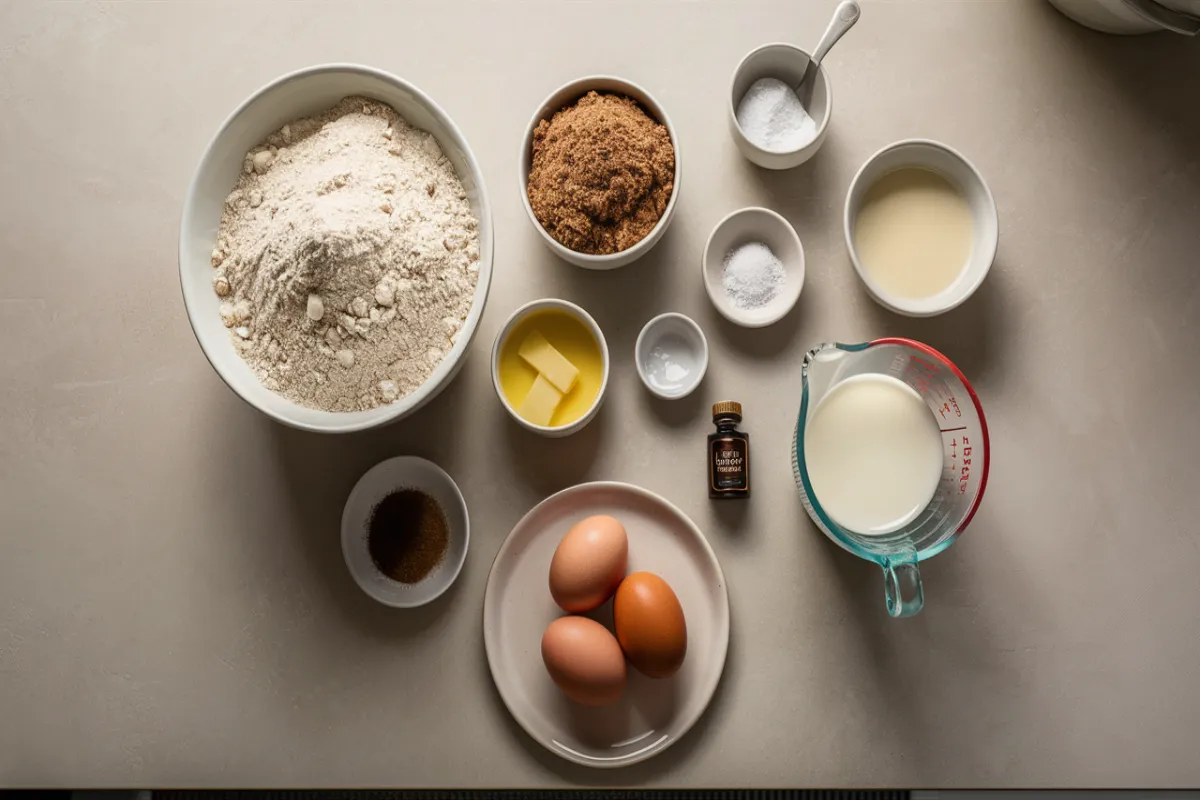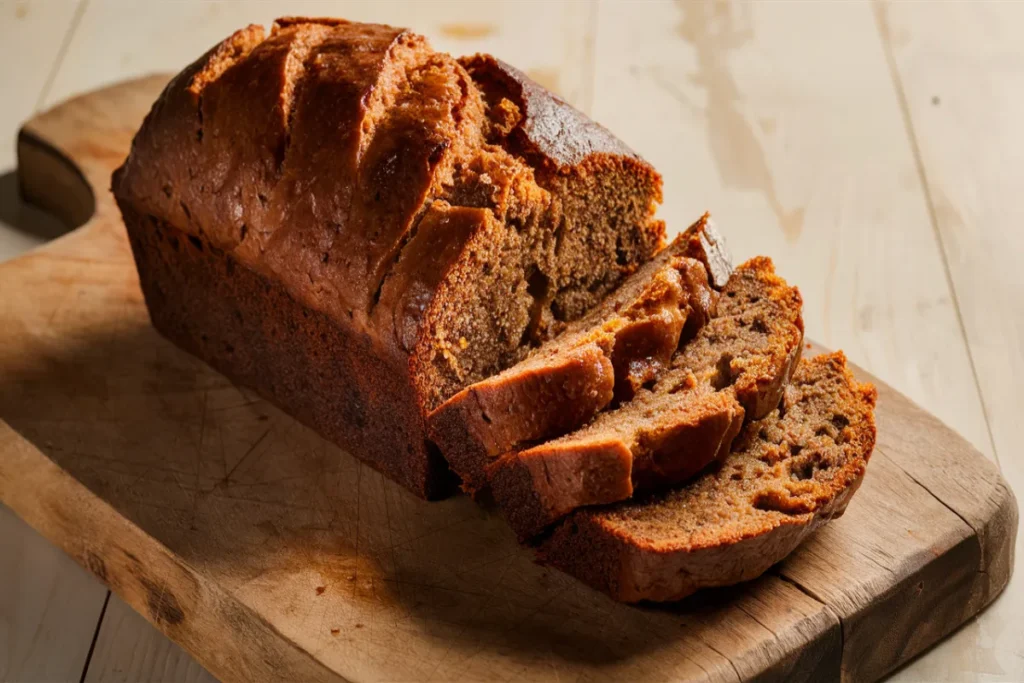Brown sugar bread is a delightful and simple bread that’s subtly sweet, moist, and perfect for enjoying on its own or with various toppings. This bread is versatile, making it an ideal choice for breakfast, a snack, or even dessert. Whether you prefer to have it with butter, jam, or a dusting of cinnamon sugar, the rich flavor of brown sugar shines through in every bite. In this comprehensive guide, we’ll cover everything you need to know about making brown sugar bread. From the ingredients you’ll need to tips and tricks for the best results, this recipe will help you achieve a perfectly baked loaf every time.
Ingredients for Brown Sugar Bread Recipe

Each ingredient in this brown sugar bread recipe plays a key role in its texture, flavor, and structure. Here is a detailed list of ingredients, their roles, and possible substitutions:
1. All-Purpose Flour (3 cups)
- Role in Recipe: Flour provides the structure and body for the bread, allowing it to rise and hold its shape during baking.
- Substitutions: You can use whole wheat flour for a heartier texture or gluten-free flour for a gluten-free version.
2. Brown Sugar (1 cup, packed)
- Role in Recipe: Brown sugar is the star ingredient, giving the bread its signature sweetness and adding moisture to the crumb.
- Substitutions: You can substitute coconut sugar or granulated sugar for a lighter flavor, but the rich, molasses-like depth of brown sugar will be missed.
3. Baking Powder (2 tsp)
- Role in Recipe: Baking powder is the leavening agent that helps the bread rise, making it light and fluffy.
- Substitutions: If you don’t have baking powder, you can substitute 1 tsp baking soda combined with 2 tsp cream of tartar.
4. Salt (1 tsp)
- Role in Recipe: Salt enhances the flavor of the bread and balances the sweetness from the brown sugar.
- Substitutions: Sea salt or kosher salt can be used, but adjust the amount slightly as they are less dense than table salt.
5. Unsalted Butter (½ cup, melted)
- Role in Recipe: Butter adds richness and moisture to the bread, making it tender and flavorful.
- Substitutions: Coconut oil or vegetable oil can be used for a dairy-free option, but the flavor will be slightly different.
6. Whole Milk (1 cup)
- Role in Recipe: Milk adds moisture to the dough and helps create a soft, tender crumb.
- Substitutions: Almond milk, oat milk, or soy milk can be used for a dairy-free version.
7. Eggs (2 large)
- Role in Recipe: Eggs provide structure, moisture, and richness to the bread, helping it rise and creating a soft texture.
- Substitutions: You can use flax eggs (1 tbsp ground flaxseed mixed with 3 tbsp water per egg) for a vegan option.
8. Vanilla Extract (1 tsp)
- Role in Recipe: Vanilla extract adds a subtle sweetness and enhances the flavor of the brown sugar.
- Substitutions: Almond extract can be used for a different flavor, or you can omit it for a more straightforward taste.
9. Ground Cinnamon (optional, 1 tsp)
- Role in Recipe: Cinnamon adds warmth and spice to the bread, complementing the sweetness of the brown sugar.
- Substitutions: You can use nutmeg or allspice for a different flavor, or omit it altogether if you prefer a plain bread.
Step-by-Step Guide to Making Brown Sugar Bread Recipe
This step-by-step guide will take you through the process of making brown sugar bread, ensuring that your bread turns out perfectly moist and flavorful every time.
Step 1: Prepare the Ingredients
- Preheat the Oven: Begin by preheating your oven to 350°F (175°C). Grease a 9×5-inch loaf pan with butter or non-stick spray, and set it aside.
- Melt the Butter: In a small saucepan or microwave-safe bowl, melt the unsalted butter and set it aside to cool slightly.
2: Mix the Dry Ingredients
- Combine the Dry Ingredients: In a large mixing bowl, whisk together the flour, brown sugar, baking powder, and salt. If using cinnamon, add it to the dry ingredients now. Whisk until everything is evenly combined and there are no lumps of brown sugar.
3: Mix the Wet Ingredients
- Beat the Eggs and Milk: In a separate mixing bowl, beat the eggs, then whisk in the milk, melted butter, and vanilla extract. Whisk until the wet ingredients are fully combined and smooth.
4: Combine the Wet and Dry Ingredients
- Mix the Batter: Gradually pour the wet ingredients into the bowl with the dry ingredients. Using a wooden spoon or spatula, gently mix the batter until just combined. Be careful not to overmix, as this can lead to dense bread. The batter should be thick but smooth.
5: Pour the Batter into the Pan
- Transfer the Batter: Pour the batter into the prepared loaf pan, using a spatula to spread it evenly.
Step 6: Bake the Brown Sugar Bread
- Bake the Bread: Place the loaf pan in the preheated oven and bake for 50-60 minutes, or until a toothpick inserted into the center comes out clean. The top of the bread should be golden brown and slightly firm to the touch.
- Cool the Bread: Remove the bread from the oven and allow it to cool in the pan for 10 minutes. Then, transfer the bread to a wire rack to cool completely before slicing.
Tips for Achieving the Best Brown Sugar Bread Recipe
To ensure your brown sugar bread turns out perfectly every time, follow these helpful tips:
Tip 1: Don’t Overmix the Batter
Overmixing the batter can cause the bread to become dense and tough. Stir until the ingredients are just combined for the best results.
Tip 2: Use Fresh Ingredients
Make sure your baking powder and other ingredients are fresh. Old baking powder can cause the bread to rise improperly, leading to a dense loaf.
Tip 3: Measure Ingredients Accurately
For consistent results, measure your ingredients accurately. Use a kitchen scale for the flour, as too much flour can make the bread dry.
Tip 4: Customize Your Brown Sugar Bread
Feel free to experiment with additional ingredients, such as chopped nuts, dried fruit, or chocolate chips, for a unique twist on the classic brown sugar bread.
Serving Suggestions for Brown Sugar Bread Recipe

Brown sugar bread is incredibly versatile, making it perfect for various occasions and pairings. Whether you enjoy it fresh out of the oven or as a next-day treat, this bread lends itself to both simple and creative serving options. Here are some ideas to elevate your brown sugar bread experience:
Classic Toasted with Butter:
A simple yet satisfying option is to slice the bread and lightly toast it. Spread a generous layer of salted butter over the warm, toasted slices for a rich, comforting treat. The butter melts into the bread, enhancing the flavor of the brown sugar and adding a slightly savory contrast to the sweetness.
With a Drizzle of Honey or Maple Syrup:
For those who enjoy a bit of extra sweetness, drizzle warm slices of brown sugar bread with honey or maple syrup. This adds a touch of stickiness and a natural sweetness that complements the caramel-like flavors of the brown sugar. It’s perfect for breakfast or dessert.
Topped with Fresh Fruit:
For a fresh and fruity twist, top your brown sugar bread with slices of fresh fruit such as strawberries, bananas, or berries. The natural acidity and juiciness of the fruit balance out the sweetness of the bread, creating a refreshing contrast. Add a dollop of whipped cream or a sprinkle of powdered sugar to complete the dish.
With Nut Butter:
Pairing brown bread with almond butter, peanut butter, or any nut butter of your choice offers a more indulgent experience. The creamy texture of the nut butter contrasts with the tender crumb of the bread, while the nutty flavors add depth to the overall taste. This is an excellent option for a quick breakfast or snack.
As a Base for French Toast:
Turn your brown sugar bread into an extra special breakfast by using it as the base for French toast. The rich flavors of the bread work wonderfully when soaked in an egg mixture and fried to perfection. Serve the French toast with a dusting of powdered sugar, a drizzle of syrup, and fresh fruit for an elevated breakfast or brunch dish.
Brown sugar bread offers endless possibilities for serving, whether you want to keep things simple or get creative with additional flavors and textures. Its sweet, moist crumb makes it a versatile option that pairs well with both savory and sweet toppings. Experiment with different pairings to find your favorite way to enjoy this delicious bread!
Frequently Asked Questions (FAQs)
1. Can I make brown sugar bread without eggs?
Yes! You can substitute the eggs with flax eggs (1 tbsp ground flaxseed mixed with 3 tbsp water per egg) or use a commercial egg replacer for a vegan version.
2. How long will brown sugar bread stay fresh?
Brown sugar bread will stay fresh for up to 3 days when stored in an airtight container at room temperature. For longer storage, you can refrigerate the bread for up to a week.
3. Can I freeze brown sugar bread?
Absolutely! Brown sugar bread freezes well. Wrap it tightly in plastic wrap, then place it in a freezer-safe bag or container. It can be frozen for up to 3 months. Thaw at room temperature before serving.
4. Can I add other ingredients to the brown sugar bread recipe?
Yes, you can customize the recipe by adding ingredients like chopped nuts, dried cranberries, raisins, or chocolate chips. Simply fold them into the batter before baking.
5. Can I make mini loaves instead of one large loaf?
Yes, you can divide the batter into mini loaf pans. Reduce the baking time to 25-30 minutes, or until a toothpick inserted comes out clean.
Pairing Suggestions for Brown Sugar Bread Recipe
Brown sugar bread pairs wonderfully with various spreads and toppings. For a savory contrast, try pairing it with cream cheese or a nut butter such as almond butter. For something sweeter, serve it with fruit preserves or a drizzle of caramel sauce. This bread also makes a great base for French toast, adding a rich sweetness that pairs well with syrup and fresh berries.
Conclusion
This brown sugar bread recipe is not only easy to make, but it’s also a comforting and versatile treat that can be enjoyed in many different ways. Whether you serve it for breakfast with coffee or as an afternoon snack, this bread’s rich flavor and moist texture are sure to impress. The subtle sweetness from the brown sugar makes it perfect for enjoying on its own or as a base for more elaborate toppings. By following this guide and experimenting with your own flavors, you’ll create a delicious brown bread that will quickly become a favorite in your household.
Leave a Reply